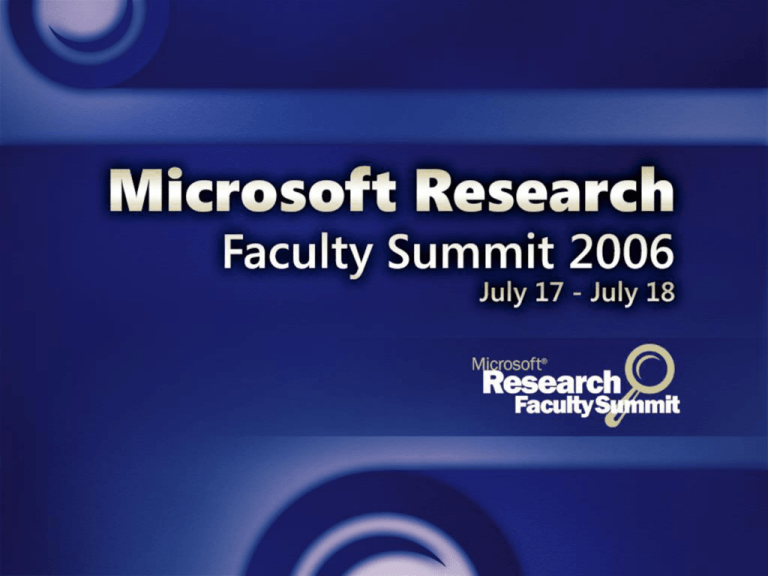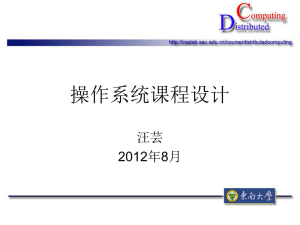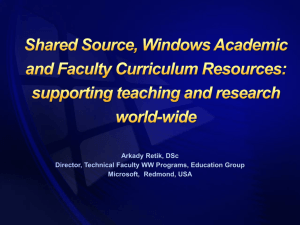
Windows Academic Program
Supporting OS Teaching And Research
Dave Probert
Shared Source History
1/ 5/ 2006 SSI Licenses
Community
CCPv3
Shared Source
Initiative
1992 1993
M SR
Selective
Sharing
2001
ESLP
2002
2003
GSP
2004
M VPSLP
Public
Sharing
Windows Academic Program
2005
Office GSP WAP
Collaborative
Sharing
Windows Academic Program Components
Windows Operating
System Internals
Curriculum Resource
Kit (CRK) –
Presentation slides,
experiments, labs,
quizzes and
assignments for
introducing case
studies from the
Windows kernel
into operating
system courses
Windows Research
Kernel –
CRK
WRK
The core kernel sources
and binaries integrated
with an environment
for building and testing
experimental
versions of the
Windows kernel
for use in teaching
and research
ProjectOZ
ProjectOZ – An operating
systems project
environment that uses the native kernel interfaces of Windows to provide
simple, clean, user-mode abstractions of the CPU, MMU, trap mechanism,
and physical memory that can be used to perform experiments in operating
systems principles
CRK (Curriculum Resource Kit)
Covers all ACM/IEEE/AIS OS BOK units and more
(based on Windows XP/Server 2003)
Scalable to multiple levels
Modular (can be used in whole/in part)
Case studies/compare and contrast
Basic modules provide materials to incorporate into a complete
basic level OS course of one semester in length; The modules
cover the Windows OS specific topics in the core and elective
units of the OS BOK of Computing Curricula 2001
Advanced modules provide materials to incorporate into an advanced
level OS course of one semester in length; The modules cover the
Windows OS specific topics in the core and elective units of the
“CC2001” OS BOK as well as in three supplementary units
Contains references to source code
CRK Units
a. Core topics
OS1. Overview of operating systms
OS2. Operating system principles
OS3. Concurrency
OS4. Scheduling and dispatch
OS5. Memory management
b. Elective topics
OS6. Device management
OS7. Security and protection
OS8. File systems
OS9. Real-time and embedded systems
OS10. Fault tolerance
OS11. System perf evaluation & troubleshooting
OS12. Scripting
c. Supplementary topics
OS-A. Windows networking
OS-B. Comparing the Linux and Windows Kernels
OS-C. Windows – Unix Interoperability
Labs and Exercises, plus refs to WRK sources
Available now@http://www.msdnaa.net/curriculum
CRK Authors
Industry
Mark Russinovich is chief software architect and
cofounder of Winternals Software
(www.winternals.com), a company that specializes
in advanced systems software for Microsoft
Windows. Mark is co-author of Inside Windows
2000, 3rd Edition (Microsoft Press) with David
Solomon andsuccessor, Windows Internals, 4th
Edition (Microsoft Press).
Mark is a Microsoft Most Valuable Professional
(MVP) and serves as senior contributing editor for
Windows IT Pro magazine where he contributes to
the Windows Power Tools column. He is also a
frequent speaker at major industry conferences
such as Microsoft Tech Ed, IT Forum, Windows IT
Pro Magazine's Connections and Redmond
Magazine's TechMentor.
Mark has a B.S. from Carnegie Mellon University
and a M.S. from Rensselaer Polytechnic Institute,
both in computer engineering. In 1994, he earned a
Ph.D. from Carnegie Mellon University, also in
computer engineering.
David Solomon (www.solsem.com) teaches
classes on Windows kernel internals to developers
and IT professionals at companies worldwide,
including Microsoft. He is the co-author of Windows
Internals, 4th edition, the official Microsoft Press
book on Windows kernel internals, as well as the
previous edition, Inside Windows 2000. David also
wrote Inside Windows NT, 2nd edition, and
Windows NT for OpenVMS Professionals. He also
co-created the Windows Internals COMPLETE
video series which Microsoft licensed for worldwide
internal training. David has served as technical
chair for three past Windows NT conferences and
has spoken at many TechEds and PDCs. He was a
recipient of the 1993 & 2005 Microsoft Support
Most Valuable Professional (MVP) award.
Academia
Andreas Polze is the Operating Systems and
Middleware Professor at the Hasso-PlattnerInstitute for Software Engineering at University
Potsdam, Germany. He received a doctoral
degree from Freie University Berlin, Germany, in
1994 and a habilitation degree from Humboldt
University Berlin in 2001, both in computer
science. His habilitation thesis investigates
Predictable Computing in MulticomputerSystems. Current research interests include
Interconnecting Middleware and Embedded
Systems, Mobility and Adaptive System
Configuration, and End-to-End Service
Availability for standard middleware platforms.
At University Potsdam, his current teaching
activities focus on architecture of operating
systems, on component-based middleware, as
well as on predictable distributed computing. Our
curriculum includes lectures that discuss
operating system issues based on standard
platforms (Windows 2000/XP, Mac OS X (BSD
Unix), and Solaris) as well as on embedded
systems (Windows CE, Embedded Linux).
Prof. Polze was a visiting scientist with the
Dynamic Systems Unit at Software Engineering
Institute, at Carnegie Mellon University,
Pittsburgh, USA, were he worked on real-time
computing on standard middleware (CORBA),
and with the Real-Time Systems Laboratory at
University of Illinois, Urbana-Champaign.
WRK (Windows Research Kernel)
Source from the latest shipping Windows (NTOS) kernel
Version – Windows Server 2003 (x86/x64) and Windows XP x64
Included sources – most everything in NTOS – processes, threads,
LPC, VM, scheduler, object manager, I/O manager, synchronization,
worker threads, kernel memory manager, …
Excluded sources – plug-and-play, power-management, and
specialized code such as the driver verifier, splash screen,
branding, timebomb, etc.
Build environment – makefile-based with object library for
the excluded sources; Kernels boot on native hardware or
using VirtualPC
WRK Goals
Simplified licensing to allow classroom
and lab use
Make it easier for faculty and students
to compare and contrast Windows to
other operating systems
Enable students to study source, and
modify and build projects
Provide better support for research and
publications based on Windows internals
Encourage more OS textbook and universityoriented internals books on Windows kernel
WRK Licensing
Goals
Faculty feel comfortable agreeing to its conditions
Students can use in classroom/lab environment
License type
Non-commercial, academic use only; allows
derivative works for non-commercial purpose
Eligibility criteria
Available to faculty and students in colleges/universities WW
Usage scenarios
View, copy, reproduce, distribute within the institution
Modify for teaching and experimentation purposes
Produce teaching and research publications including
relevant snippets of source
Can use in textbooks and academic publications, and community forums
Have to perpetuate Microsoft copyright notices
Share derivatives within academic community
ProjectOZ Experimental
Environment For OS Projects
An OS project environment using NTAPI
Provides simple, user-mode abstractions
CPU, MMU, trap mechanism, and physical memory
Supports experiments in OS principles
Use real OS features rather than a ‘toy’ simulation
Reduce complexity required to learn/build experiments
A simple development environment, using standard
tools for building, debugging, and instrumentation
Encourage ‘out-of-the-box’ thinking by students
Based on SPACE project at UCSB (Probert and Bruno)
ProjectOZ
workloads
ProjectOZ
BasicOZ
SPACE.exe
Workloads, tests,
instrumentation
Student projects
and experiments
Initial OS implementation
1. Small amount of code
2. Students inspired to do better
SPACE abstractions of
CPU, MMU, Traps
NT native API
NT Kernel
Windows
ProjectOZ runs in usermode on a standard
Windows system
BasicOZ
A very simple OS implementation
Familiar functionality (processes, threads,
user/kernel, virtual memory, devices, namespaces)
Minimal implementations using simple algorithms
and providing limited functionality
Small amount of code (~2-3 kloc)
Based on SPACE primitives built on NTAPI
Goals
Students have limited code to read/modify
Underlying abstractions are clean and simple
BasicOZ seems too rudimentary – inspiring students
Windows Research Kernel
NT Timeline First 17 Years
2/1989
7/1993
9/1994
5/1995
7/1996
12/1999
8/2001
3/2003
8/2004
4/2005
2006
Coding Begins
NT 3.1
NT 3.5
WRK
NT 3.51
NT 4.0
NT 5.0 Windows 2000
NT 5.1 Windows XP
NT 5.2 Server 2003
NT 5.2 Windows XP SP2
NT 5.2 Windows XP 64 Bit Edition (and WS03SP1)
NT 6.0 Windows Vista (client)
15
Windows Architecture
Applications
Subsystem
servers
DLLs
System Services
Kernel32
Critical services
Login/GINA
User32/GDI
ntdll/run-time library
User-mode
Kernel-mode
Trap interface / LPC
Security refmon
I/O Manager
Net devices
File filters
Net protocols
File systems
Net Interfaces
Volume mgrs
Virtual memory
Procs and threads
Win32 GUI
Filesys run-time
Scheduler
Cache mgr
Synchronization
Device stacks
Object Manager/Configuration Management (registry)
Kernel run-time/Hardware Adaptation Layer
Important NT Kernel Features
Highly multi-threaded
Completely asynchronous I/O model
Thread-based scheduling
Object-manager provides unified management of
Kernel data structures
Kernel references
User references (handles)
Namespace
Synchronization objects
Resource charging
Cross-process sharing
Centralized ACL-based security reference monitor
Configuration store decoupled from file system
17
Important NT Kernel Features
Extensible filter-based I/O model with driver
layering, standard device models, notifications,
tracing, journaling, namespace,
services/subsystems
Virtual address space managed separately
from memory objects
Advanced VM features for databases (app
management of virtual addresses, physical
memory, I/O, dirty bits, and large pages)
Plug-and-play, power-management
System library mapped in every process
provides trusted entry points
NT Kernel Design Workbook
NT OS/2 Design Workbook: Core OS
File
Title
Author(s)
dwintro
NT OS/2 Design Workbook Introduction
Lou Perazzoli
ke
NT OS/2 Kernel Specification
David N. Cutler,
Bryan M. Willman
alerts
NT OS/2 Alerts Design Note
David N. Cutler
apc
NT OS/2 APC Design Note
David N. Cutler
ob
NT OS/2 Object Management Specification
Steven R. Wood
proc
NT OS/2 Process Structure
Mark Lucovsky
suspend
NT OS/2 Suspend/Resume Design Note
David N. Cutler
attproc
NT OS/2 Attach Process Design Note
David N. Cutler
vm
NT OS/2 Virtual Memory Specification
Lou Perazzoli
vmdesign
NT OS/2 Memory Management Design Note
Lou Perazzoli
io
NT OS/2 I/O System Specification
Darryl E. Havens
irp
NT OS/2 IRP Language Definition
Gary D. Kimura
namepipe
NT OS/2 Named Pipe Specification
David Cutler & Gary Kimura
mailslot
NT OS/2 Mailslot Specification
Manny Weiser
rsm
Windows NT Session Management and Control
Mark Lucovsky
fsdesign
NT OS/2 File System Design Note
Gary D. Kimura
fsrtl
NT OS/2 File System Support Routines Specification
Gary D. Kimura
NT Kernel Design Workbook
NT OS/2 Design Workbook: Core OS
File
Title
Author(s)
sem
NT OS/2 Event – Semaphore Specification
Lou Perazzoli
argument
NT OS/2 Argument Validation Specification
David N. Cutler
timer
NT OS/2 Timer Specification
David N. Cutler
coding
NT OS/2 Coding Conventions
Mark Lucovsky,
Helen Custer
ulibcode
NT Utilities Coding Conventions
David J. Gilman
exceptn
NT OS/2 Exception Handling Specification
David N. Cutler
os2
OS/2 Emulation Subsystem Specification
Steven R. Wood
status
NT OS/2 Status Code Specification
Darryl E. Havens
ntdesrtl
NT OS/2 Subsystem Design Rational
Mark H. Lucovsky
resource
NT OS/2 Shared Resource Specification
Gary D. Kimura
execsupp
NT OS/2 Executive Support Routines Specification
David Treadwell
support
NT OS/2 Interlocked Support Routines Specification
David N. Cutler
dd
Windows NT Driver Model Specification
Darryl E. Havens
oplock
NT OS/2 Opportunistic Locking Design Note
Darryl Havens, et al
memio
NT OS/2 Memory Management Guide for I/O
Lou Perazzoli
time
NT OS/2 Time Conversion Specification
Gary D. Kimura
mutant
NT OS/2 Mutant Specification
David N. Cutler
NT Kernel Design Workbook
NT OS/2 Design Workbook: Core OS
File
Title
Author(s)
prefix
NT OS/2 Prefix Table Specification
Gary D. Kimura
startup
NT OS/2 System Startup Design Note
Mark Lucovsky
dbg
NT OS/2 Debug Architecture
Mark Lucovsky
coff
NT OS/2 Linker/Librarian/Image Format Spec
Michael J. O'Leary
cache
NT OS/2 Caching Design Note
Tom Miller
ntutil
NT OS/2 Utility Design Specification
Steven D. Rowe
implan
NT OS/2 Product Description and Implementation Plan
David N. Cutler
basecont
NT OS Base Product Contents
Lou Perazzoli
WRK Organization
arb
Plug-and-play arbiter
lpc
Local inter-process calls
cache
Cache Manager
mm
Memory Manager
config
Registry
nls
Internationalization code
dbgk
User-mode debugging
ob
Object Manager
ex
Executive functions
perf
Performance Tracing
fsrtl
File system run-time
po
Power Management
fstub
File sys boot interface
ps
Process/thread
inc
Kernel-specific includes
raw
Raw volume driver
init
Boot code
rtl
Kernel run-time library
io\iomgr
I/O manager
se
Security Ref Monitor
io\pnpmgr
Plug-and-play manager
vdm
Virtual Dos Machine
kd64
Kernel debug interface
verifier
Driver Verifier
ke
Kernel (scheduler, etc)
wmi
Windows Mgmt Interface
Building The WRK
See README.txt
path %wrk%\tools\x86;%path%
cd %wrk%\base\ntos
nmake x86=
Edit \boot.ini file of system or VirtualPC
add entry specifying kernel and hal
WRK Organization
doxygen callgraphs For The WRK
Prof. Dr. Andreas Polze
Hasso-Plattner-Institute
for Software Systems Engineering
Operating Systems and Middleware Chair
polze@hpi.uni-potsdam.de
www.dcl.hpi.uni-potsdam.de
www.polze.de/andreas
Compare And Contrast
OS design environments
Address space
UNIX
NT
(1970s)
(1980/1990s)
16b, swapping 32-bit, linear VM
??
(2000/2010s)
64-bit, ??
CPU perf
KIPS
MIPS
GIPS
IRQL
Test&Set,
Cmpr&Swap
Transactional
memory?
Memory size
KBytes
MBytes
GBytes
Hard concurrency
none
SMP
High-Multicore
Mass storage
Kbytes,
slow seek
Mbytes,
slow seeks
GBytes, no seeks
TBytes
Distrib. computing
Tape
Client/server
Peer-to-peer
Synchr
Old OS designs can (of course) be ported, but
How you would design an OS on blank paper?
How should the CPU system architecture evolve?
Compare And Contrast
Key NTOS Design Decisions
Thread is unit of concurrency
Unified synchronization and naming mechanisms
Namespace not rooted in file system
Separated Virtual Address and
Memory Object management
Asychronous, extensible I/O model (filtering)
ACL-based security, token-based identity
Integrated configuration-store
System library mapped into every process
Operating Systems Of The Future?
Security architecture, mechanisms, and tools
Application models for state mgmt and system extensibility
Code analysis using tools like the Phoenix compiler
Integration of managed and non-managed technologies
Implementation of simpler kernel abstractions
Object-based kernel services
User-mode ‘kernel’ services (drivers, extensions)
Version and upgrade management for platform and apps
Management of complexity
Federation of distributed computing and storage devices
Summary And Contact Information
CRK
Core, Elective and Supplementary units available for free download
ProjectOZ and WRK
Available for download
Feedback
Contact us at compsci@microsoft.com
More information on WAP and related topics
Shared Source Web Site
http://www.microsoft.com/resources/sharedsource/Licensing/Windows
Academic.mspx
Forums for discussion and access to Windows kernel and arch team
http://forums.microsoft.com/WindowsAcademic
Curriculum Repository on MSDNAA
http://www.msdnaa.net/curriculum/pfv.aspx?ID=6191
© 2006 Microsoft Corporation. All rights reserved.
Microsoft, Windows, Windows Vista and other product names are or may be registered trademarks and/or trademarks in the U.S. and/or other countries.
The information herein is for informational purposes only and represents the current view of Microsoft Corporation as of the date of this presentation.
Because Microsoft must respond to changing market conditions, it should not be interpreted to be a commitment on the part of Microsoft,
and Microsoft cannot guarantee the accuracy of any information provided after the date of this presentation.
MICROSOFT MAKES NO WARRANTIES, EXPRESS, IMPLIED OR STATUTORY, AS TO THE INFORMATION IN THIS PRESENTATION.










